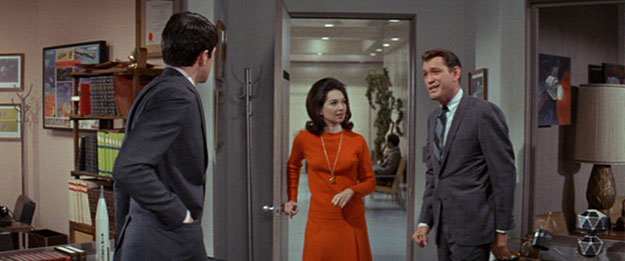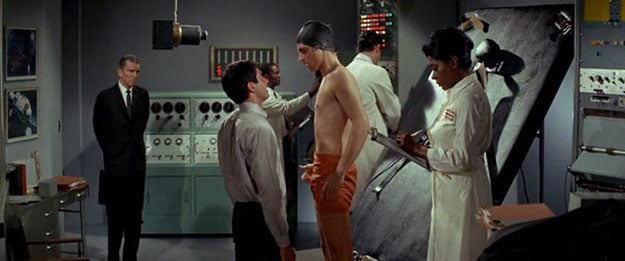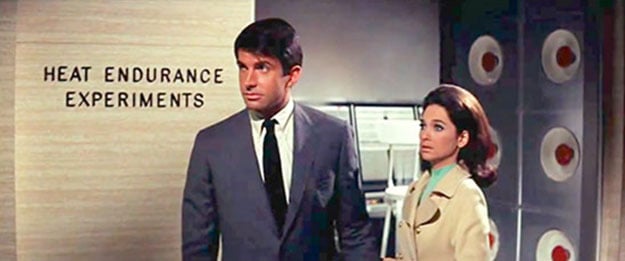TCM Diary: Don’t Fight The Power (1968)

Two men amble through a high-tech laboratory, which is palpably an old-school, over-lit, studio-built set. They are research facility chief Dr. Jim Tanner (George Hamilton), whose ballpoint-crammed pocket protector seems at odds with his modified moptop haircut, and Arthur Nordlund (Michael Rennie), a stern government overseer who represents the Establishment despite being played by the hippie alien from The Day the Earth Stood Still. The pair chat amiably about Tanner’s clearly sadistic experiments in pain tolerance, undertaken at the behest of the space program. The time, as the opening credit tells us, is “Tomorrow,” as it is in so many sci-fi films.
As their bland conversation continues, they stroll casually across the lab, until they pass in front of—oh, nothing much really, just a half-naked man bound up and bathed in devil-red light, his face contorted in agony. Tanner and Nordlund barely glance over at him, unruffled at having apparently walked into a Kenneth Anger tableau. “How can we protect him in space,” Tanner asks, “if we don’t know how much pain he can take, how much torture he can endure?” This nonsensical reasoning might provide an excuse for a government program, but it doesn’t have much to do with the plot that follows.
This moment demonstrates some of the strangeness of The Power (1968), a sci-fi film adapted from a novel by Frank M. Robinson (who also provided one of the sources for The Towering Inferno, did the “Playboy Advisor” column for a few years, and wrote speeches for Harvey Milk). The Power falls into a category I happen to cherish, mid-to-late ’60s films where the slow-motion collision between the last vestiges of the Hollywood studio system and the counterculture can be seen playing out on screen. This includes films by successful early adapters like Mike Nichols or Paul Mazursky, but also projects from old pros who suddenly found themselves in a bizarre cultural era, trying to create something that could speak to, and utilize, the new freedoms. Some big-name examples are the acid (lysergic and otherwise) zaniness of Otto Preminger’s Skidoo, or the whiff of Aquarius that Jack Nicholson carries into Vincente Minnelli’s On a Clear Day You Can See Forever.

The Power is an MGM release featuring a huge roster of veteran talent, notably producer George Pal (whose final film as a director was 1964’s 7 Faces of Dr. Lao, another movie that feels caught between two film cultures), and Byron Haskin, whose directing career included genre gems like Robinson Crusoe on Mars and the Pal-produced War of the Worlds, and whose tenure in the MGM special effects department reached all the way back to the studio’s super-production of A Midsummer Night’s Dream, in 1935. The credits are stocked with longtime MGM staffers such as hair stylist Sydney Guilaroff, a fixture at the studio since the 1930s. These seasoned pros found themselves working on a wiggy mind-control story a year after the release of Sgt. Pepper and Corman’s The Trip. Clearly this movie needed something groovier for the youth crowd that would be its target audience, so Pal and Haskin & Co. did their best to provide that.
Fitfully, they succeeded. Unfortunately, the movie keeps pulling against its own wilder impulses. For instance, George Hamilton. Although he was not yet 30 in 1968, George Hamilton had already passed out of his first leading-man phase (rather good in Minnelli’s Home from the Hill [1960], not so good in the showbiz-bible Moss Hart memoir Act One [1963]) and into something of a punch line—I mean, by this time he’d dated Lyndon Johnson’s daughter. Suzanne Pleshette plays Margery Lansing, professor of genetics and cellular theory at Tanner’s lab, and just as importantly someone Tanner can stretch out with on the rug in his bachelor pad (she wants to discuss how they might genetically engineer the man of the future, he wants to get them out of their pocket protectors). The rest of the cast, including most of the other scientists at the pain institute, are played by reliable if slightly musty folks who had been round the block a few times: Arthur O’Connell, Earl Holliman, Yvonne De Carlo, Nehemiah Persoff, Gary Merrill, and that rock of 1950s sci-fi, Richard Carlson.
In the realm of science fiction, MGM’s 1968 release slate also included 2001: A Space Odyssey and The Green Slime. The Power is much stodgier than either of those titles, but its stabs at cutting-edge stylishness emerge every few minutes. The credits are a happening, thrumming along to Miklos Rozsa’s hammer-dulcimer musical score, and the design of the lab—the scientists’ offices share a common transparent wall—is one of the best things in this vein until The Andromeda Strain three years later. When it becomes clear that one scientist is a superman with telekinetic powers—revealed in a scene where the staff sits in a circle and somebody moves a piece of paper at the center of the table—the film shifts into a whodunit, as a wrongly discredited Tanner tries to discover the identity of the mega-brain, who is now killing the other scientists with psyche-waves.

It’s disappointing when the movie becomes a murder mystery, because at that point the “man of tomorrow” talk and the telekinesis are relegated to background material. But The Power has a crazy color scheme, a zoom-happy visit to a funhouse, and a curious moment when Tanner thinks he sees toys in a shop window come to life (some Pal-style stop-motion animation there). And during the big mind-off at the end we see the film’s answer to 2001’s stargate sequence, as Tanner is depicted in various states of cosmic deconstruction, including a moment when the flesh melts off his skeleton.
All of which is depicted in a kind of professional, non-visionary way, as you would imagine a group of professional, no-nonsense studio hands would do it. It’s odd enough to stand out, and too workmanlike to actually enchant. That’s The Power, a movie that uses its ESP to sense the changes in the air, but can’t quite push through its own studio-bound traditionalism to enter the—you know—next dimension.
The Power airs October 11 on Turner Classic Movies.
Robert Horton is a writer based in Seattle.







